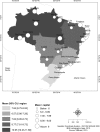Contextual and individual determinants of tooth loss in adults: a multilevel study
- PMID: 32183780
- PMCID: PMC7076961
- DOI: 10.1186/s12903-020-1057-1
Contextual and individual determinants of tooth loss in adults: a multilevel study
Abstract
Background: Tooth loss represents a known marker of health inequality. The association between tooth loss and unfavorable socioeconomic conditions is evident when analyzed at an individual level. However, the effects of contextual characteristics on tooth loss need to be better investigated and understood. The objective of this study was to analyze tooth loss among Brazilian adults (35-44 years of age), in accordance with individual and contextual social characteristics.
Methods: This was a multilevel cross-sectional study with data from 9564 adult participants from the Brazilian Oral Health Survey - SBBrasil 2010. The dependent variable was the number of lost teeth and the independent variables were grouped into structural (socioeconomic & political context) and intermediary (socioeconomic position, behavioral & biological factors, and health services) determinants. Multilevel Hierarchical Negative Binomial Regression was conducted and the Mean Ratio (MR) was estimated.
Results: Brazilian adults lost a mean of 7.57 (95% CI 7.1-8.1) teeth. Among the contextual variables, the number of teeth lost was higher among residents of municipalities with high and medium/low Municipal Human Development Index (MHDI) and in municipalities that did not have public water fluoridation. Among the individual variables, dental loss was higher among those who declared themselves yellow/black/brown/indigenous, were older, who had lower income, who had never visited a dentist, who had used dental services for more than a year and those whose most recent visit to the dentist was due to oral health problems. On the other hand, dental loss was lower among adults with higher education levels and males.
Conclusions: The number of missing teeth was associated with unfavorable contextual and individual conditions, which reinforces the need to reduce social inequality and guarantee regular, lifetime access to dental services.
Keywords: Adult; Health inequalities; Multilevel analysis; Tooth loss.
Conflict of interest statement
The authors declare that they have no competing interests.
Figures
Similar articles
-
Education and income-based inequality in tooth loss among Brazilian adults: does the place you live make a difference?BMC Oral Health. 2020 Sep 4;20(1):246. doi: 10.1186/s12903-020-01238-9. BMC Oral Health. 2020. PMID: 32887590 Free PMC article.
-
Functional Dentition in Brazilian Adults: An Investigation of Social Determinants of Health (SDH) Using a Multilevel Approach.PLoS One. 2016 Feb 10;11(2):e0148859. doi: 10.1371/journal.pone.0148859. eCollection 2016. PLoS One. 2016. PMID: 26862892 Free PMC article.
-
The role of municipal public policies in oral health socioeconomic inequalities in Brazil: A multilevel study.Community Dent Oral Epidemiol. 2018 Jun;46(3):245-250. doi: 10.1111/cdoe.12356. Epub 2017 Dec 7. Community Dent Oral Epidemiol. 2018. PMID: 29215153
-
The Relationship between Income and Oral Health: A Critical Review.J Dent Res. 2019 Jul;98(8):853-860. doi: 10.1177/0022034519849557. Epub 2019 May 15. J Dent Res. 2019. PMID: 31091113 Review.
-
Tooth loss from the perspective of studies employing a life course approach: a systematic review.Health Promot Int. 2024 Oct 1;39(5):daae112. doi: 10.1093/heapro/daae112. Health Promot Int. 2024. PMID: 39322426
Cited by
-
Individual- and City-Level Socioeconomic Factors and Tooth Loss among Elderly People: A Cross-Level Multilevel Analysis.Int J Environ Res Public Health. 2020 Mar 30;17(7):2345. doi: 10.3390/ijerph17072345. Int J Environ Res Public Health. 2020. PMID: 32235684 Free PMC article.
-
Analysis of epidemiological trends of and associated factors for tooth loss among 35- to 44-year-old adults in Guangdong, Southern China, 1995-2015: a population-based cross-sectional survey.BMC Oral Health. 2023 Feb 5;23(1):74. doi: 10.1186/s12903-023-02776-8. BMC Oral Health. 2023. PMID: 36740667 Free PMC article.
-
Multimorbidity and tooth loss: data from Chilean National Health Survey 2016-2017.BMC Oral Health. 2024 Nov 20;24(1):1417. doi: 10.1186/s12903-024-05184-8. BMC Oral Health. 2024. PMID: 39567956 Free PMC article.
-
Association between chronic kidney disease and tooth loss among Korean adults: results from the Korea National Health And Nutrition Examination Survey (KNHANES), 2013-2018.Ren Fail. 2025 Dec;47(1):2531239. doi: 10.1080/0886022X.2025.2531239. Epub 2025 Jul 20. Ren Fail. 2025. PMID: 40685514 Free PMC article.
-
Contextual and individual factors associated with self-reported tooth loss among adults and elderly residents in rural riverside areas: A cross-sectional household-based survey.PLoS One. 2022 Nov 22;17(11):e0277845. doi: 10.1371/journal.pone.0277845. eCollection 2022. PLoS One. 2022. PMID: 36413557 Free PMC article.
References
-
- Sanders AE, Slade GD, Turrell G, Spencer AJ, Marcenes W. Does psychological stress mediate social deprivation in tooth loss? J Dent Res. 2007;86(12):1166–1170. - PubMed
-
- Peres MA, Barbato PR, Reis SCGB, Freitas CHSM, Antunes JLF. Tooth loss in Brazil: analysis of the 2010 Brazilian Oral Health Survey. Rev Saude Publica. 2013;47(Supl 3):1–11. - PubMed
-
- Barbato PR, Nagano HCM, Zanchet FN, Boing AF, Peres MA. Perdas dentárias e fatores sociais, demográficos e de serviços associados em adultos brasileiros: uma análise dos dados do Estudo Epidemiológico Nacional (Projeto SB Brasil 2002-2003) Cad Saude Publica. 2007;23(8):1803–1814. - PubMed
-
- Thomson WM. Social inequality in oral health. Community Dent Oral Epidemiol. 2012;40(Supl 2):28–32. - PubMed
-
- Hamasha AA, Sasa I, Al-Qudah M. Risk indicators associated with tooth loss in Jordanian adults. Community Dent Oral Epidemiol. 2000;28(1):67–72. - PubMed
Publication types
MeSH terms
LinkOut - more resources
Full Text Sources
Medical



